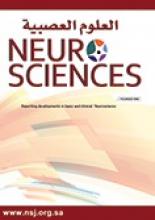Review ArticleReview Article
Open Access
Evidence-based neurosurgery
Basic concepts for the appraisal and application of scientific information to patient care (Part II)
Ignatius N. Esene, Saleh S. Baeesa and Ahmed Ammar
Neurosciences Journal July 2016, 21 (3) 197-206; DOI: https://doi.org/10.17712/nsj.2016.3.20150553
Ignatius N. Esene
From the Department of Neurosurgery (Esene), Ain Shams University, the Gamma Knife Center (Esene), Nasser Institute, Cairo, Egypt, the Department of Neurosurgery (Ammar), Dammam University, Dammam, and the Division of Neurosurgery (Baeesa), Department of Surgery, Faculty of Medicine, King Abdulaziz University, Jeddah, Kingdom of Saudi Arabia
MD, MPHSaleh S. Baeesa
From the Department of Neurosurgery (Esene), Ain Shams University, the Gamma Knife Center (Esene), Nasser Institute, Cairo, Egypt, the Department of Neurosurgery (Ammar), Dammam University, Dammam, and the Division of Neurosurgery (Baeesa), Department of Surgery, Faculty of Medicine, King Abdulaziz University, Jeddah, Kingdom of Saudi Arabia
MBChB, FRCSCAhmed Ammar
From the Department of Neurosurgery (Esene), Ain Shams University, the Gamma Knife Center (Esene), Nasser Institute, Cairo, Egypt, the Department of Neurosurgery (Ammar), Dammam University, Dammam, and the Division of Neurosurgery (Baeesa), Department of Surgery, Faculty of Medicine, King Abdulaziz University, Jeddah, Kingdom of Saudi Arabia
MD, PhD
References
- ↵
- Sackett DL,
- Rosenberg WM,
- Gray JA,
- Haynes RB,
- Richardson WS
- ↵
- Yarascavitch BA,
- Chuback JE,
- Almenawer SA,
- Reddy K,
- Bhandari M
- ↵
- Bhandari M,
- Joensson A
- ↵
- Isaacs D,
- Fitzgerald D
- ↵
- Fletcher RH,
- Fletcher SW
- ↵
- Komotar RJ,
- Starke RM,
- Raper DM,
- Anand VK,
- Schwartz TH
- ↵
- Esene IN,
- El-Shehaby AM,
- Baeesa SS
- ↵
- Pollock BE
- ↵
- Roitberg B
- ↵
- Farrokhyar F,
- Karanicolas PJ,
- Thoma A,
- Simunovic M,
- Bhandari M,
- Devereaux PJ,
- et al.
- ↵
- Egger M,
- Smith GD,
- Sterne JA
- ↵
- Haidich AB
- ↵
- Linskey ME
- ↵
- Bandopadhayay P,
- Goldschlager T,
- Rosenfeld JV
- ↵
- Haines SJ
- ↵
- Sackett DL,
- Straus SE,
- Richardson WS,
- Rosenberg W,
- Haynes RB
- ↵
- Wupperman R,
- Davis R,
- Obremskey WT
- ↵
- Medina JM,
- McKeon PO,
- Hertel J
- ↵
- Akobeng AK
- ↵
- Ho PM,
- Peterson PN,
- Masoudi FA
- ↵
- Liu JC,
- Stewart MG
- ↵
- Esene IN,
- Ngu J,
- Elzoghby M,
- Solaroglu I,
- Sikod AM,
- Kotb A,
- et al.
- ↵
- Kaiser MG,
- Eck JC,
- Groff MW,
- Watters WC 3rd.,
- Dailey AT,
- Resnick DK,
- et al.
- ↵
- Brain Trauma Foundation
- ↵
- Anderson PA,
- Matz PG,
- Groff MW,
- Heary RF,
- Holly LT,
- Kaiser MG,
- et al.
- ↵
- Feigin VL,
- Bennett DA
- ↵
- Downs SH,
- Black N
- ↵
- Kochanek PM,
- Carney N,
- Adelson PD,
- Ashwal S,
- Bell MJ,
- Bratton S,
- et al.
- ↵
- Garg AX,
- Hackam D,
- Tonelli M
- ↵
- Eddy DM
- ↵
- Knuth T,
- Letarte PB,
- Ling G,
- Moores LE
- ↵
- Greenberg M
- ↵
- Rosenberg J,
- Greenberg MK
- ↵
- Timmermans S,
- Mauck A
- ↵
- Burls A
- ↵
- Moher D,
- Schulz KF,
- Altman DG
- Begg C,
- Cho M,
- Eastwood S,
- Horton R,
- Moher D,
- Olkin I,
- et al.
- Tooth L,
- Ware R,
- Bain C,
- Purdie DM,
- Dobson A
- Von EE,
- Altman DG,
- Egger M,
- Pocock SJ,
- Gotzsche PC,
- Vandenbroucke JP
- Stroup DF,
- Berlin JA,
- Morton SC,
- Olkin I,
- Williamson GD,
- Rennie D,
- et al.
- Moher D,
- Liberati A,
- Tetzlaff J,
- Altman DG
- Vandenbroucke JP
- ↵
- Shea BJ,
- Grimshaw JM,
- Wells GA,
- Boers M,
- Andersson N,
- Hamel C,
- et al.
- ↵
- Guyatt G,
- Oxman AD,
- Akl EA,
- Kunz R,
- Vist G,
- Brozek J,
- et al.
- ↵
- Charlton BG
- ↵
- Bricolo AP,
- Pasut LM
- ↵
- Poolman RW,
- Petrisor BA,
- Marti RK,
- Kerkhoffs GM,
- Zlowodzki M,
- Bhandari M
- ↵
- Grol R
- ↵
- Grimshaw JM,
- Russell IT
- ↵
- Shin JH,
- Haynes RB,
- Johnston ME
In this issue
Evidence-based neurosurgery
Ignatius N. Esene, Saleh S. Baeesa, Ahmed Ammar
Neurosciences Journal Jul 2016, 21 (3) 197-206; DOI: 10.17712/nsj.2016.3.20150553
Related Articles
- No related articles found.
Cited By...
- No citing articles found.





